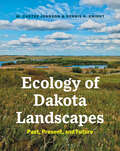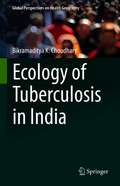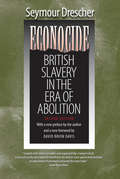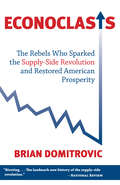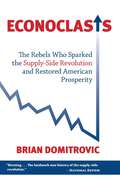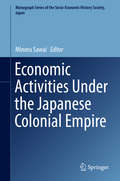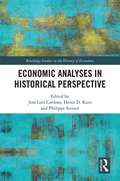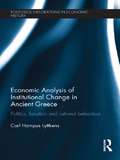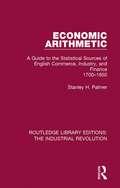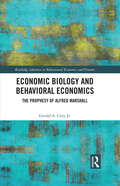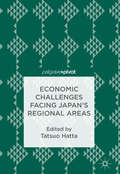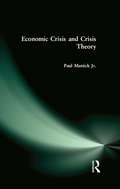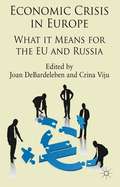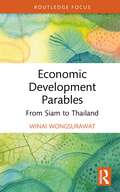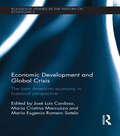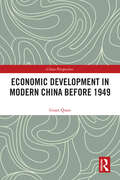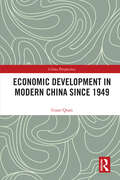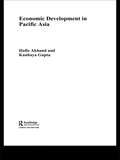- Table View
- List View
Ecology and Ethnogenesis: An Environmental History of the Wind River Shoshones, 1000–1868 (New Visions in Native American and Indigenous Studies)
by Adam R. HodgeIn Ecology and Ethnogenesis Adam R. Hodge argues that the Eastern Shoshone tribe, now located on the Wind River Reservation in Wyoming, underwent a process of ethnogenesis through cultural attachment to its physical environment that proved integral to its survival and existence. He explores the intersection of environmental, indigenous, and gender history to illuminate the historic roots of the Eastern Shoshone bands that inhabited the intermountain West during the nineteenth century. Hodge presents an impressive longue durée narrative of Eastern Shoshone history from roughly 1000 CE to 1868, analyzing the major developments that influenced Shoshone culture and identity. Geographically spanning the Great Basin, Rocky Mountain, Columbia Plateau, and Great Plains regions, Ecology and Ethnogenesis engages environmental history to explore the synergistic relationship between the subsistence methods of indigenous people and the lands that they inhabited prior to the reservation era. In examining that history, Hodge treats Shoshones, other Native peoples, and Euroamericans as agents who, through their use of the environment, were major components of much broader ecosystems. The story of the Eastern Shoshones over eight hundred years is an epic story of ecological transformation, human agency, and cultural adaptation.Ecology and Ethnogenesis is a major contribution to environmental history, ethnohistory, and Native American history. It explores Eastern Shoshone ethnogenesis based on interdisciplinary research in history, archaeology, anthropology, and the natural sciences in devoting more attention to the dynamic and often traumatic history of “precontact” Native America and to how the deeper past profoundly influenced the “postcontact” era.
Ecology of Dakota Landscapes: Past, Present, and Future
by W. Carter Johnson Dennis H. KnightAn illustrated review of the Northern Great Plains that blends natural history and human history &“The most complete, in-depth look at Dakota ecosystems and their history. An absolutely fascinating read!&”—Gabe Brown, author of Dirt to Soil W. Carter Johnson and Dennis H. Knight describe the natural and human histories of the Northern Great Plains in this comprehensive and handsomely illustrated book. Covering a vast period of time, they move from geological developments millions of years ago and the effects of glaciers to historical and ecological developments in recent centuries and the effects of agriculture. The book ends with a discussion of the future of this region, mediated by climate change, with recommendations on how to balance agriculture and other pressing needs in the twenty-first century. Johnson and Knight bring decades of experience to chapters on the major ecosystems of the Dakotas. Written for readers with varying backgrounds, and with discussions of the Prairie Pothole Region, the Missouri River, grasslands, woodlands, the Black Hills, and rivers, lakes, and wetlands, the book is unique and will become a long-lasting source of information. Readers will appreciate the plentiful photographs and other color illustrations.
Ecology of Tuberculosis in India (Global Perspectives on Health Geography)
by Bikramaditya K. ChoudharyThe book addresses the issue of disease diffusion across the geographical span of India during the colonial period. Based on archival records, it analyses colonial economic policies and their implications for the spread of the disease across different regions of India as well as the role of the military in disease spread. It adds a new dimension to the understanding of the spread of TB in colonial India.The book also discusses the concept of the meaning of illness for different cohorts of TB patients. Based on narratives, it brings to readers the social and cultural dimensions that are responsible for the prevalence of the disease, despite having vaccination and medication available for more than half a century.The book will be beneficial to health and medical geographers and will bring new insights in historical geography as well as the history of medicine, by incorporating policy changes and their implication in disease spread. Sociologists and public health professionals will find narratives of patients interesting and useful for furthering their understanding.
Econocide British Slavery in the Era of Abolition
by Seymour DrescherIn this classic analysis and refutation of Eric Williams's 1944 thesis, Seymour Drescher argues that Britain's abolition of the slave trade in 1807 resulted not from the diminishing value of slavery for Great Britain but instead from the British public's mobilization against the slave trade, which forced London to commit what Drescher terms "econocide. " This action, he argues, was detrimental to Britain's economic interests at a time when British slavery was actually at the height of its potential. Originally published in 1977, Drescher's work was instrumental in undermining the economic determinist interpretation of abolitionism that had dominated historical discourse for decades following World War II. For this second edition, which includes a foreword by David Brion Davis, Drescher has written a new preface, reflecting on the historiography of the British slave trade since this book's original publication.
Econoclasts: The Rebels Who Sparked the Supply-Side Movement and Restored American Prosperity (Culture Of Enterprise Ser.)
by Brian DomitrovicThe history we can't afford to forgetAt last, the definitive history of supply-side economics--an incredibly timely work that reveals the foundations of America's prosperity when those very foundations are under attack.In the riveting, groundbreaking book Econoclasts, historian Brian Domitrovic tells the remarkable story of the economists, journalists, Washington staffers, and (ultimately) politicians who showed America how to get out of the 1970s stagflation and ushered in an unprecedented quarter-century run of growth and opportunity.Based on the author's years of archival research, Econoclasts is a masterful narrative history in the tradition of Amity Shlaes's The Forgotten Man and John Steele Gordon's An Empire of Wealth.
Econoclasts: The Rebels Who Sparked the Supply-Side Revolution and Restored American Prosperity
by Brian DomitrovicThe history we can't afford to forget. At last, the definitive history of supply-side economics—an incredibly timely work that reveals the foundations of America's prosperity when those very foundations are under attack. In the riveting, groundbreaking book Econoclasts, historian Brian Domitrovic tells the remarkable story of the economists, journalists, Washington staffers, and (ultimately) politicians who showed America how to get out of the 1970s stagflation and ushered in an unprecedented quarter-century run of growth and opportunity. Based on the author's years of archival research, Econoclasts is a masterful narrative history in the tradition of Amity Shlaes's The Forgotten Man and John Steele Gordon's An Empire of Wealth.
Economic & Philosophic Manuscripts of 1844
by Karl MarxThese early writings of Marx throw new light upon the origins and formative period of Marxism. Major emphasis is on alienation of the laborer in capitalist society.
Economic Activities Under the Japanese Colonial Empire
by Minoru SawaiThe mainfocus of this editedvolume is an examination of dynamic relationships among Japan, Taiwan, Korea, and the northeastern region of China, and the economic development of each area in East Asia from the 1910s to the end of WorldWar II. The development of foreign trade in East Asia, therelations between industrialization and consumption in Korea, the transactions infertilizers and the development of small-scale industries in Taiwan are preciselyexamined. Atpresent, East Asia is a major economic center of the world. It is necessary to lookclosely not only at both sides of the "exploitation or development undercolonization" paradigm but also at the prewar factors that spurred East Asian economicgrowth in the postwar decades. A noteworthy characteristic of the Japanese colonial empirewas the close economic and geographic relations among Japan, Taiwan, Korea, and the northeastern region of China. Economic integration within the empire strengthenedconsiderably in the interwar years and remained high even during the war ascompared to that in European countries and their colonies. What was theirreversible change in each colonial economy by means of forced incorporationinto the Japanese empire? What was the impact on economic subjects such asmerchants, manufacturers, managers, and workers through the colonial regime? Thisbook provides readers with broad perspectives that are indispensable given thatthe factors discussed herein are the historical origins of current issues.
Economic Analyses in Historical Perspective (Routledge Studies in the History of Economics)
by José Luís Cardoso Heinz D. Kurz Philippe SteinerThis book brings together leading scholars of the history of economic thought to demonstrate the vitality and richness of a discipline that welcomes both practitioners of intellectual, contextual history, as well as specialists in the historical explanation of the analytical and theoretical dimension of economic science. They shed new light on a variety of themes and problems and move the frontier of knowledge in the areas covered. Economic Analyses in Historical Perspective is presented in three parts. The first deals with French traditions in economics, a field that Gilbert Faccarello has tilled for many years and to which he has made numerous contributions. The second turns to the dissemination and diffusion of economic ideas and theories across national borders, and thus to the European and even global level. Finally, the third part deals with analytical developments in some selected fields of economics: public economics, monetary policy, trade theory and spatial economics. This volume is of great importance to those who study history of economic thought, political economy and monetary economics. The chapters’ centre around the work of Gilbert Faccarello, making this book a fitting tribute to his academic career on the history of economic theory and ideas.
Economic Analysis of Institutional Change in Ancient Greece: Politics, Taxation and Rational Behaviour (Routledge Explorations in Economic History)
by Carl Hampus LyttkensThis book presents an economic analysis of the causes and consequences of institutional change in ancient Athens. Focusing on the period 800-300 BCE, it looks in particular at the development of political institutions and taxation, including a new look at the activities of individuals like Solon, Kleisthenes and Perikles and on the changes in political rules and taxation after the Peloponnesian War.
Economic Analysis of Provincial Land Use Policies in Ontario
by Mark W. Frankena David T. ScheffmanThis book describes and analyses the provincial government's role in municipal and regional planning. The conversion of farmland to urban and other uses is discussed, as are the issues raised by the reports of the Ontario Planning Act Review Committee and the Federal/Provincial Task Force on the Supply and Price of Serviced Residential Land and the province's Green Paper on Planning for Agriculture. The authors criticize the government's failure to conduct cost-benefit studies before setting up planning programs and show that there is little factual basis for recent alarm over the disappearance of farmland. Data gathered here for the first time show that the conversion of agricultural land to built-up urban use and non-farm rural residential use in Ontario has been taking place quite slowly in view of the rate of productivity increase in agriculture, the stock of agricultural land, and the decline in the acreage of census farms. Economists will find in this book a useful survey of recent trends and policies. Planners, policy-makers, and students will welcome this detailed case study of how economic analysis ought to be used in formulating land use policies.
Economic Arithmetic: A Guide to the Statistical Sources of English Commerce, Industry, and Finance, 1700-1850 (Routledge Library Editions: The Industrial Revolution #7)
by Stanley H. PalmerEconomic history is the most quantitative branch of history, reflecting the interests and profiting from the techniques and concepts of economics. This essay, first published in 1977, provides an extensive contribution to quantitative historiography by delivering a critical guide to the sources of the numerical data of the period 1700 to 1850. This title will be of interest to students of history, finance and economics.
Economic Assistance and Conflict Transformation: Peacebuilding in Northern Ireland (Routledge Studies in Peace and Conflict Resolution)
by Sean ByrneThis book examines the role of economic aid in the management and resolution of protracted ethnic conflicts, focusing on the case study of Northern Ireland. The book describes the results of a study of the role of economic aid within Northern Ireland, through the viewpoints of citizens collected in an opinion poll as well as community group leaders whose projects received funding, funding-agency civil servants and development officers. The study explains the importance of economic and social development in promoting cross-community contact as well as within single-identity communities, and the need for a multitrack intervention approach to transform the conflict in Northern Ireland. It makes an important contribution to our understanding of how economic assistance impacts on a divided society with a history of protracted violence and provides important perspectives on the "peace through development" idea. One of the key unanswered questions relating to economic aid and preventing future violence is that of the significance of external economic aid in building peace after violence. By examining the respondents’ political imagery, this book expands on existing work on economic aid and peace building in other societies coming out of violence. Northern Ireland’s changing social-economic and political context reflects the fact that economic aid and sustainable economic development is a cornerstone of the peacebuilding process. The goal of the book is to provide a foundational knowledge base for students and practitioners about the role of economic aid in building the peace dividend in post-accord societies. The book will be of great interest to students of conflict resolution, peacebuilding, Irish politics, peace and conflict studies, and politics and IR in general.
Economic Biology and Behavioral Economics: The Prophesy of Alfred Marshall (Routledge Advances in Behavioural Economics and Finance)
by Gerald A. Cory Jr.Economic Biology and Behavioral Economics: The Prophesy of Alfred Marshall explores the prophesy of Alfred Marshall, the grand synthesizer of neoclassical economics, that the "Mecca of the economist lies in economic biology". The book presents the proof of that prophesy through examination and establishment of the fundamental biological science necessary and then applying that science to the examination of current economic theory. In doing so, the book focuses primarily on the fundamentals of neoclassical economic theory— which is the reigning theory and the general framework of which is taught as "science" in first courses in college economics. These courses are at best an idealization, if not an ideology, of the discipline—presented to fresh minds misleadingly as confirmed science. The book examines the bases and the history of these idealizations, points to the sources of their error from the biological perspective and suggests a path forward for the discipline. Through this process, the book demonstrates the power of the biological perspective anticipated by Marshall. This book provides invaluable reading for anyone interested in the future of economics and economic theory, and particularly those interested in behavioral economics and neuroeconomics.
Economic Challenges Facing Japan’s Regional Areas
by Tatsuo HattaThis book analyzes issues related to economic challenges for Japan's regional revitalization. Japan's responses to such challenges and to the problem of an aging population are of deep interest to the nations outside of Japan. This book brings together 19 articles contributed by Japan's leading scholars, originally prepared for an online policy information portal, SPACE NIRA launched by the Nippon Institute for Research Advancement (NIRA) with Dr. Tatsuo Hatta, President of the Asian Growth Research Institute, as its General Editor. This book is a significant and useful reference for all scholars, students, and individuals with an interest in current policy issues in Japan.
Economic Change in Modern Indonesia
by Anne BoothIndonesia is often viewed as a country with substantial natural resources which has achieved solid economic growth since the 1960s, but which still faces serious economic challenges. In 2010, its per capita GDP was only nineteen per cent of that of the Netherlands, and twenty-two per cent of that of Japan. In recent decades, per capita GDP has fallen behind that of neighbouring countries such as Malaysia and Thailand, and behind China. In this accessible but thorough new study, Anne Booth explains the long-term factors which have influenced Indonesian economic performance, taking into account the Dutch colonial legacy and the reaction to it after the transfer of power in 1949. The first part of the book offers a chronological study of economic development from the late nineteenth to the early twenty-first century, while the second part explores topics including the persistence of economic nationalism and the ongoing tensions between Indonesia's diverse regions.
Economic Crisis And Political Economy
by Riccardo Bellofiore Jan Toporowski Ewa KarwowskiRosa Luxemburg, Oskar Lange and Michal Kalecki made important contributions to twentieth century political economy that guided the thinking of their student Tadeusz Kowalik. The chapters of this volume examine how the ideas of Luxemburg, Lange, Kalecki and Kowalik can illuminate our understanding of the crisis in twenty-first century capitalism.
Economic Crisis and Crisis Theory
by Paul Mattick Jr.Keynesian economics claimed to have overcome the problem of economic depressions. However, as Mattick argues that crises are inherent within capitalism and that neither the market nor Keynesianism can stop "the steady deterioration of the economy". Written in 1974, Economic Crisis and Crisis Theory is one of Mattick's most valuable contributions to the Marxist critique of political economy and radical theory in general.
Economic Crisis in Europe
by Joan Debardeleben Crina VijuThe financial crisis of 2008-09 took an unexpected turn upon challenging a core symbol of Europe's integration project, the Euro. In this volume, leading experts tackle questions on the capacity of the EU to respond, the manner discontent electorates will hold their leaders to account, and the implications for Europe's future relations with Russia.
Economic Development In The Americas Since 1500: Endowments And Institutions
by Kenneth L. Sokoloff Stanley L. Engerman Stephen Haber Elisa V. Mariscal Eric M. ZoltThis book brings together a number of previously published articles by Stanley L. Engerman and Kenneth L. Sokoloff. Its essays deal with differences in the rates of economic growth in Latin American and mainland North America, specifically the United States and Canada. It demonstrates how relative differences in growth over time are related to differences in the institutions that developed in different economies. This variation is driven by differences in major institutions - suffrage, education, tax policy, land and immigration policy, and banking and financial organizations. These factors, in turn, are all related to differences in endowments, climate, and natural resources. Providing a comprehensive treatment of its topic, the essays have been revised to reflect new developments and research.
Economic Development Parables: From Siam to Thailand (Routledge Studies in the Modern World Economy)
by Winai WongsurawatWongsurawat looks at the history of Thailand since the mid-nineteenth century and uses events to elucidate basic economic models and concepts. He selects defining moments in Thailand’s history to convey key economic ideas worthy of classroom discussion.Written without excessive jargon, the chapters connect complex historical phenomena with broader, transportable economic concepts. The cases range from the signing of the Bowring Treaty in 1855, opening Siam to the forces of globalization, to the Asian Financial Crisis that wreaked havoc on the economy in 1997. Key economic terms are also explained. Reconnecting the increasingly distant fields of history and economics, this is an appealing text to researchers with an interest in Thailand’s economic history, as well as undergraduates undergoing an introductory economics course or overseas program in Thailand.
Economic Development and Global Crisis: The Latin American Economy in Historical Perspective (Routledge Studies in the History of Economics #161)
by José Luís Cardoso Maria Cristina Marcuzzo María Eugenia Romero SoteloThis edited collection uses a history of economic thought perspective to explore the evolving role of Latin America within the context of globalization. In particular, it examines the region’s resilience in the face of the global financial crisis. Economic Development and Global Crisis explains that Latin America is a region with distinct characteristics and peculiarities which have been shaped from the colonial era up to the present day. The contributions suggest that several features which were perceived as economic backwardness have turned out to be advantageous, and this may explain why Latin America is withstanding the crisis much better than Europe, Japan and the USA. This book will be of interest to scholars working in the areas of economic development, economic history, the history of economic thought and Latin American studies.
Economic Development in Modern China Before 1949 (China Perspectives)
by Guan QuanAs the first volume of a two-volume set on Chinese economic history, this book investigates Chinese economic development between 1912 and 1949 and unravels the overall level during that time. From the perspective of development economics, the two-volume set studies the economic history and development of China since 1912, with a focus on the quantitative analysis of economic activities. Comprised of two core parts, this first volume, centering on the period of the Republic of China, first describes the historical process and characteristics of the economy at different stages and then looks into the momentum and inner logic that underpin the economic development. The former part covers issues of agriculture, industry, population, and labour force, urbanization, price changes, people’s consumption and living standard, regional difference, etc. The latter part includes discussions on natural and human resources, capital formation and technological progress, the role of government and finance, international trade, and foreign capital. This title will be an interesting read for scholars and students working on Chinese economic history, the Chinese economy, and modern Chinese society.
Economic Development in Modern China Since 1949 (China Perspectives)
by Guan QuanAs the second volume of a two-volume set on the Chinese economic history, this book investigates Chinese economic development since 1949, uncovering the momentum, unique models, and general laws of economy in China.From the perspective of development economics, the two-volume set studies the economic history and development of China since 1912, with a focus on the quantitative analysis of economic activities. This volume describes the historical process and characteristics of the economy since 1949, then looks into the momentum and inner logic that underpin the economic development. The former part covers issues of agriculture, industry, population and labor force, urbanization and mobility, income distribution and poverty, and price changes. The latter part includes analyses on the capital formation, human resources, technological progress, institutions, macro policies, international trade, and direct investment.This title will interest scholars and students working on Chinese economic history, the Chinese economy, and modern Chinese society.
Economic Development in Pacific Asia
by Hafiz Akhand Kanhaya GuptaDuring the period 1965 to 1990 East Asia was the world’s fastest growing region. Economic Development in Pacific Asia provides illuminating, non-technical perspectives on key facets of the region’s economies. The text focuses on the eight countries which accounted for the majority of the economic growth: Japan, Hong Kong, Taiwan, Republic of Korea, Indonesia, Malaysia, Singapore and Thailand. Empirical evidence is used to provide a revealing, multi-dimensional statistical profile of the countries as well as the region as a whole. Rather than present a statistical history of each country, the text highlights the relative performance in terms of the variables which are studied within each chapter. Akhand and Gupta examine a range of popular topics including: the relative role of factors accumulation versus technology change factor price distribution and employment growth, poverty and income distribution the Asian Crisis and corruption. In addition, the book examines topics rarely covered in the current economics literature such as urbanization, the gender gap and the digital divide. It provides an accessible and wide ranging assessment of the existing evidence and current arguments on East Asian economic development, and is a valuable addition to economists, policy makers and those interested in Asian economic affairs.

